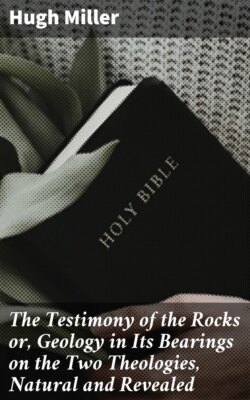The Testimony of the Rocks or, Geology in Its Bearings on the Two Theologies, Natural and Revealed

Реклама. ООО «ЛитРес», ИНН: 7719571260.
Оглавление
Hugh Miller. The Testimony of the Rocks or, Geology in Its Bearings on the Two Theologies, Natural and Revealed
The Testimony of the Rocks or, Geology in Its Bearings on the Two Theologies, Natural and Revealed
Table of Contents
MEMORIALS
A PRAYER
THE TESTIMONY OF THE ROCKS
LECTURE FIRST
LECTURE SECOND
LECTURE THIRD
LECTURE FOURTH
LECTURE FIFTH
LECTURE SIXTH
LECTURE SEVENTH
LECTURE EIGHTH
LECTURE NINTH
LECTURE TENTH
LECTURE ELEVENTH
LECTURE TWELFTH
FOOTNOTES:
Отрывок из книги
Hugh Miller
Published by Good Press, 2019
.....
The study of plants and animals seems to have been a favorite one with thoughtful men in every age of the world. According to the Psalmist, these great "works of the Lord are sought out of all them that have pleasure therein." The Book of Job, probably the oldest writing in existence, is full of vivid descriptions of the wild denizens of the flood and desert; and it is expressly recorded of the wise old king, that he "spake of trees, from the cedar tree that is in Lebanon, even unto the hyssop that springeth out of the wall; and also of beasts, and of fowl, and of creeping things, and of fishes." Solomon was a zoologist and botanist; and there is palpable classification in the manner in which his studies are described. It is a law of the human mind, as has been already said, that, wherever a large stock of facts are acquired, the classifying principle steps in to arrange them. "Even the rudest wanderer in the fields," says Dr. Brown, "finds that the profusion of blossoms around him—in the greater number of which he is able himself to discover many striking resemblances—may be reduced to some order of arrangement." But, for many centuries, this arranging faculty labored but to little purpose. As specimens of the strange classification that continued to obtain down till comparatively modern times, let us select that of two works which, from the literary celebrity of their authors, still possess a classical standing in letters—Cowley's "Treatise on Plants," and Goldsmith's "History of the Earth and Animated Nature." The plants we find arranged by the poet on the simple but very inadequate principle of size and show. Herbs are placed first, as lowest and least conspicuous in the scale; then flowers; and, finally, trees. Among the herbs, at least two of the ferns—the true maidenhair and the spleenwort—are assigned places among plants of such high standing as sage, mint, and rosemary: among the flowers, monocotyledons, such as the iris, the tulip, and the lily, appear among dicotyledons, such as the rose, the violet, the sunflower, and the auricula: and among trees we find the palms placed between the plum and the olive; and the yew, the fir, and the juniper, flanked on one side by the box and the holly, and on the other by the oak. Such, in treating of plants, was the classification adopted by one of the most learned of English poets in the year 1657.
Nor was Goldsmith,-who wrote more than a century later, much more fortunate in dealing with the animal kingdom. Buffon had already published his great work; and even he could bethink him of no better mode of dividing his animals than into wild and tame. And in Goldsmith, who adopted, in treating of the mammals, a similar principle, we find the fishes and molluscs placed, in advance of the sauroid, ophidian, and batrachian reptiles—the whale united in close relationship to the sharks and rays—animals of the tortoise kind classed among animals of the lobster kind, and both among shell fish, such as the snail, the nautilus, and the oyster. And yet Goldsmith was engaged on his work little more than eighty years ago. In fine, the true principles of classification in the animal kingdom are of well nigh as recent development as geologic science itself, and not greatly more ancient in even the vegetable kingdom. It would, of course, be wholly out of place to attempt giving a minute history here of the progress of arrangement in either department; but it can scarce be held that the natural system of plants was other than very incomplete previous to 1789, when Jussieu first enunciated his scheme of classification; nor did it receive its later improvements until so late as 1846, when, after the publication, in succession, of the schemes of De Candolle and Endlicher, Lindley communicated his finished system to the world. And there certainly existed no even tolerably perfect system of zoology until 1816, when the "Animal Kingdom" of Cuvier appeared. Later naturalists—such as Agassiz, in his own special department, the history of fishes, and Professor Owen in the invertebrate divisions—have improved on the classification of even the great Frenchman; but for purposes of comparison between the scheme developed in geologic history and that at length elaborated by the human mind, the system of Cuvier will be found, for at least our present purpose, sufficiently complete. And in tracing through time the course of the vegetable kingdom, let us adopt, as our standard to measure it by, the system of Lindley.
.....